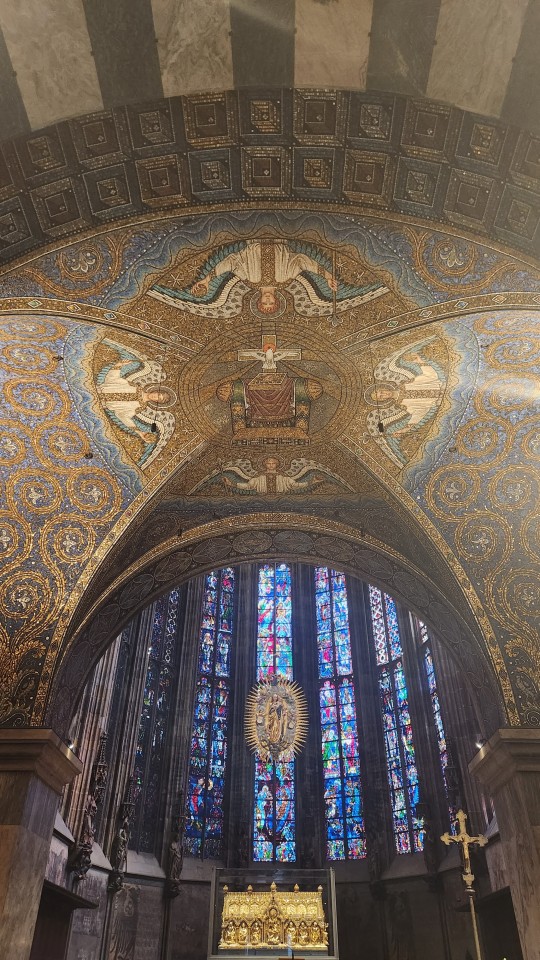Text

Just across the river from Saint Peter’s, the outside of this building’s simplicity is striking and was enough for me to take a quick photo.
This site’s significance lies in its association with Huldrych Zwingli, one of the main leaders of the Protestant movement. He taught his doctrines and trained his followers here, the location of his initiation of the reformation in Switzerland. Starting in 1520 he won a series of debates that led local authorities in Zurich to break away from the Catholic church. The introduction of his reform led to the abolishing of mass, lent and a handful of other traditions. The Grossmunster was transformed into a place of learning and worship for the reformed faith.
The Grossmunster became the University of Zurich, one of the many examples of the repurposing of religious institutions and its permeating into other facets of society. On top of the theological studies offered, humanist studies were taught here.
Buildings have a special place in the hearts of humanity. A fixture of society that may not have existed in an ideal world, our nakedness is something we could not accept after we gained mortality. We like to be contained— within clothes, within walls, within borders— so we invent containers. And just as our bodies, which were designed to be impervious, we believe our institutions to be, despite our newfound decay. We love to remember what we left behind in our beginning, despite the continuous knocking down God reminds us of our transgressions with. We have a home, but it's no surprise we care so much about the one God created for us initially. All to say, the continued existence of any building this age is a surprise.
0 notes
Text

This quaint building in Geneva, although not one I was able to enter, was one expected to be a lot larger. Maybe it's bigger on the inside!
This building was used as a lecture hall, university and church for religious refugees arriving in Geneva by John Calvin. Originally a catholic chapel, the utility of this auditory in the reformation era was primarily as the location where Calvin taught his doctrines and trained his followers. The auditory was a symbol of the reformation’s challenge to the Catholic Church and the Holy Roman Empire, as well as its contribution to education and culture.
The focus on education did not end with the reformation. The auditory was the original home of the University of Geneva. It was the first university in Europe to be established by a Protestant reformer. Usually, when referring to the theological, many use it to mean the opposite of intellectual pursuits. It is interesting how, throughout the many stages of history, religious and educational institutions were inseparable.
0 notes
Text

The ornate design of the interior of this cathedral made it easily one of my favorite church buildings.
This cathedral that is the burial place of Charlemange was a contested ground between the Catholic and Protestant factions. Martin Luther’s visit to Aachen in 1520 saw him preaching against veneration of relics and indulgences and later the clashing of his followers with Catholic authorities. In 1547, Emperor Charles V visited Aachen and ordered the restoration of the Catholic faith and the removal of all Protestant books and images from the cathedral.
Despite King Charles efforts the protestant movement in Aachen did not end at his decree, in 1581 the city joined the Protestant Union of Utrecht, opposing the Catholic Habsburg rule. Until 1614, the cathedral was used for both Catholic and Protestant services. This coexistence ended when Catholic forces of the Thirty Years’ War captured Aachen and expelled the Protestants, restoring it to its primarily Catholic use and remaining to this day.
The relics still contained in this cathedral are numerous despite the Protestant members’ disdain for this and are still protected to this day. I find the human plight of finitude in what seems an infinite universe and our fight against it very interesting. How we know we are made for more but continue to search for our life in things that may outlive us, but still will one day crumble.
0 notes
Text

The contrast that this building has with the surrounding sky and buildings made it stick out visually to me. The burgundy color of the tower and gold clock face makes this structure stick out like a sore thumb.
The Romanesque style reflects its ties with the holy Roman empire, the main political and religious power at the time of its construction. In 1525, the Anabaptists seized the city of Maastricht and tried to destroy the church and its treasures, but they were eventually defeated. In 1632, after Maastrich’s capture by the Dutch republic the church was allowed to remain catholic, but had to share a space with the protestant church of Saint John. This site is a testament to the turbulent nature of the reformation era, and shows the complexity of the religious landscape.
The resilience or maybe luck of this building surprised me. The fact that the building has survived as it has despite the shifting governance may show the piety of most of humanity, or at least their appreciation of beauty.
0 notes
Text
This enclosed area of buildings is something I found particularly beautiful in Bruges and feels very cozy and isolated, both things that I admire. A fortress of solitude for introspection, peace and discipline to flourish.
The Beguinage was a semi monastic religious community of women who devoted themselves to prayer, charity, and service while maintaining some independence. Their display of personal piety based in individual faith and scripture alone resonates with protestant ideals and inspired some of the movements.
What surprised me most about this religious settlement was its demonstration of how women could play an active and influential role in religious life, even in a time with many more constraints.
1 note
·
View note